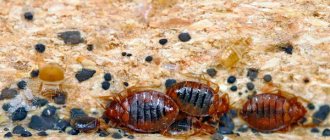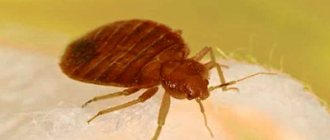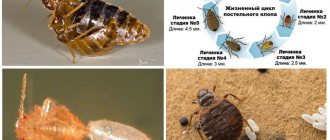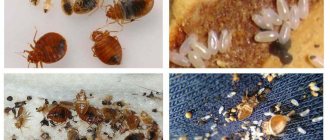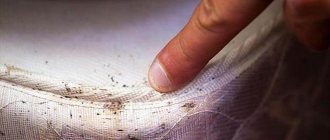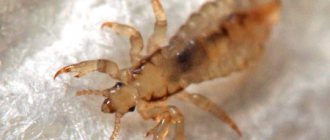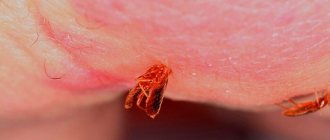It’s rare to walk through the forest, especially in the southern regions and the middle zone, without meeting shield bugs. These bugs can be found on trees, bushes, and grass. There they feed, reproduce, and breed. And while their number is limited, no particular harm is felt from them.
As the population increases, not only parks and squares, but also farmland and summer cottages begin to suffer.
- 3.1 What to do if you are bitten by a wood bug?
What do garden bugs look like?
Almost all bugs living in the garden belong to the stink bug family. This name is explained by the fact that when viewed from above, their body looks like a shield and has a flattened shape. At the same time, the type of garden bugs is diverse. They can be of different sizes - from 0.3 mm to 18 mm. They come in different colors - brown, green, red, etc. There are very bright types, with signal, warning colors. They may have stripes and other patterns on their shell.
The most common types of bugs found in gardens are:
- The green stink bug is the most common pest bug; it has a bright green color and is quite large in size - up to 1.5 cm; feeds on the juice of cultivated plants, prefers raspberry and currant leaves, can also infect herbaceous plants;
- Berry stink bug - this insect has a bright red-brown color, which is due to the fact that this pest sucks juices not only from the leaves of berry bushes, but also from berries; also known as the stink bug because when crushed it emits a pungent and unpleasant odor;
- Cruciferous bug - northern eurydema, a bug that causes great damage to garden plants - cabbage, lettuce, radish, radish; has a bright black and red color;
- The cucumber bug is a pest that destroys the leaves of cucumbers, as well as eggplants, tomatoes, and peppers; It is small in size and brown-green in color;
- The bug is a harmful turtle - outwardly the insect's shell is similar to the shell of a turtle, which explains the name, and the harmfulness lies in the fact that this garden pest destroys cereal crops, and if they are not nearby, it can suck the juices from garden plants; has developed wings, so it can fly long distances;
- Pear laceweed is a very small insect pest that feeds on the sap of fruit plants - apple trees, pears, quince, plums, etc.; This is a brown bug with an openwork pattern on its shell;
- The horse fly bug is a very small gray insect, some subspecies look like ants.
Who can be confused with
In central Russia there are many varieties: the berry bug, which damages the leaves and fruits of various berry crops, and the meadow bug, which lives on herbaceous vegetation and ornamental crops.
There are different types of cruciferous bugs: the cabbage bug, which damages cabbage, radishes, turnips, etc. Pests include the sorrel bug, some lace bugs, and the pear bug.
There are bedbugs that can cause harm only occasionally. These are soldier bugs that prefer fallen seeds and fruits, organic debris and dead insects, but sometimes damage seedlings of garden crops.
Stink bugs should not be confused with their smaller cousins, bed bugs. A telltale sign of a bed bug infestation is small black spots on wallpaper or bed frames because the animals have left their excrement there.
Beneficial predator bugs
A number of insects from the order of bugs, on the contrary, are useful in the household. They are even bred specifically to minimize the use of chemicals to protect the crop.
How bedbugs can be useful:
- macrolophus - one of the subspecies of the horse fly bug - eats eggs, larvae and adults of aphids, whiteflies, thrips, spider mites;
- perillus - destroys its natural enemies - Colorado potato beetles, as well as leaf beetles and butterflies;
- Podisus is another predatory bug that destroys caterpillars, butterflies and leaf beetles;
- picromerus is a predatory bug that preys on butterflies, sawflies, Colorado potato beetles, cutworms and other crop pests;
- Soldier bug - feeds on the remains of insects and plants, thereby cleaning the area, and is a sanitarian.
The use of predatory bugs, which are specially bred in biofactories and research institutes, allows us to minimize the use of insecticides and obtain a healthier harvest.
Prevention
The simplest and most accessible means for everyone to prevent the appearance of bedbugs in the home is a mosquito net, which will prevent insects from entering an apartment or house (considering the size of an adult bedbug is about 15 mm, and sometimes 20 mm, it will not be able to overcome such a barrier), on In garden plots, it is necessary to collect and destroy all fallen leaves and tops, so that the forest bug does not settle for the winter on your plot, where it will subsequently begin to multiply very quickly. It is also advisable to dig up the area so that after winter suspended animation it is more difficult for surviving bugs to get to the surface.
What harm do garden bugs cause?
Garden bugs need plants to feed on. They suck out their juice by making punctures in the leaves, stems, fruits and seeds. After such a puncture, holes remain in the plants, the tissues around them die, and then the entire plant dies. Bedbugs are especially dangerous during the period of plant growth and fruit formation. If the bugs suck the juices from the inflorescences, then there will simply be no fruit. If they feed on the juice of fruits and berries, the latter become unsuitable for food. Bedbugs infect all plants in the garden or vegetable garden - fruits and berries, cereals, cruciferous plants, umbelliferous plants, herbaceous plants, and ornamental plants. The speed of destruction can be very fast. For example, a horse fly bug eats a plant in a matter of hours, so the gardener may not have time to take measures to get rid of pests and protect the crop.
Interesting Facts
Interesting facts include the following:
- as it turned out, the bug can smell human sweat ten meters away;
- the specific smell is absolutely harmless to humans, but poisonous to some other insects;
- smell serves as a means of communication between insects and serves as a kind of pheromone to attract partners during the mating period;
- for all their external unattractiveness, in behavior the males and females of the forest bug, unlike other species of their own kind, show themselves to be caring parents and partners, in particular, the female provides food only for the hatched larvae, and the male, in the absence of a suitable leaf or stem for laying eggs, exposes his back to the female for this purpose.
How to get rid of garden bugs
First of all, they need to be detected. If there are suspicions that an area is infested with bedbugs, it is necessary to carry out a visual inspection, paying attention to the back of the leaves on trees and shrubs. In the greenhouse, you also need to carefully examine the back side of the leaves. Clutches of eggs can be located on the leaves, as well as at their junction with the stem.
Traditional methods
Do not neglect traditional methods of controlling garden pests. It can be:
- planting a black cohosh plant - its smell is unpleasant for bedbugs;
- spraying with infusion of onion peels - prepare it at the rate of 250 g of peels per 10 liters of water, leave for 5 days, after which the plants are sprayed once every four days;
- treatment with a solution of laundry soap (300 grams per 10 liters) once a week; You can also dilute wood ash in water along with soap;
- treating plants with a solution of dry mustard every three days.
Traditional methods of fighting bedbugs work, but their disadvantage is their short duration of action. Re-processing of the vegetable garden or garden should be carried out every 3 to 7 days. In this case, each plant needs to be treated, and each leaf must be treated on both sides, since bedbugs can move quite quickly and temporarily wander into weeds or mown grass.
Prevention methods include scattering tobacco dust, dry mustard or hot pepper over the area in the spring, before planting. They will repel or destroy pests, their larvae and eggs in the soil.
Biological method
That is, the use of other insect predators against insect pests. But it is almost impossible to implement this technique on your own, since you need to know exactly what type of bedbugs is to be destroyed and what natural enemies this species has.
Agrotechnical method
To prevent bedbugs from infecting your dacha or garden plot, the following measures must be taken:
- compliance with planting deadlines;
- timely application of fertilizers and loosening of the soil;
- weeding beds;
- clearing the area of fallen leaves, removing grass after mowing;
- maintaining cleanliness in the area.
Timely planting and maintaining the soil in an optimal condition for growing plants makes them more resistant to damage by bugs and other pests. In fallen leaves and mown grass, bedbugs can overwinter or lay eggs. They move from weeds to cultivated plants.
Chemical control method
The most effective way to get rid of garden bugs is to use chemical insecticides. Products containing organophosphorus and pyrethroid substances are suitable. You can use complex preparations to independently destroy garden pests. You can spray the drug "Medilis-Ziper" to destroy bedbugs, mosquitoes, ticks and other pests.
Chemical insecticides act in different ways:
- systemic - penetrate into plants, the insect dies after sucking the juice of such a plant;
- contact - when treating the area, the product gets on the pest, causing it to die;
- intestinal - the bug eats a microdose of poison and dies.
The issue of treating a garden plot with pesticides should only be raised if there is a large infestation of bedbugs. It is necessary to weigh the pros and cons of such treatment, since its results can harm not only the bugs, but also the crop. The use of chemicals is always an emergency measure when other methods of control do not work.
Bed bugs come from dirty homes, but if your home is clean, you're safe.
In fact, bed bugs don’t care how neat and clean your home is. Even if you are an ideal housewife, you may encounter such a problem. If you have blood in your veins that will serve as food for insects, they will be happy to take up residence in your home! The same applies to hotels and resorts. The presence of bed bugs has nothing to do with the level of cleanliness of the establishment. Even a five-star hotel can have bedbugs. However, it's worth remembering that clutter can make getting rid of bedbugs more difficult. If they have already appeared, they will look for places to hide, and all the extra things will provide them with such a place. Put things in order if you want to get rid of the problem as quickly and as efficiently as possible.
Description
Science knows several types of forest bugs, and representatives of each of them will have their own original coloring. But at the same time, the body structure of everyone is almost the same - it is flattened and represented by the shape of an irregular pentagon. The color will vary from rich green to dark brown.
On a note! The color of the forest bug is directly related to the area of its habitat and allows it to perfectly camouflage itself with the shade of foliage and tree bark!
As you can see in the photo, the body of the forest bug is covered with a dense, hard shell, which performs a protective function. Under the chitin there are two pairs of wings: the front pair is leathery and more durable, the back pair is thin membranous wings. With their help, the insect can fly, covering considerable distances.
On the head of the forest bug there are long antennae and a thin proboscis, which is a sucking organ.
Reproduction and development
Waking up after hibernation, forest bugs immediately begin to look for food for themselves. After saturation, they begin to mate. Moreover, during this period, insects usually gather in numerous colonies - this allows each individual to quickly find a suitable pair for itself.
The female lays eggs directly at the feeding site. As a rule, it places the clutches on the stems or the lower part of the leaf plate. The female forest bug attaches each egg to the surface with a special secretion, which provides them with reliable fixation.
On a note! Females lay clutches in mid-summer - it is during this period that the most optimal conditions are provided for this. And if the year turns out to be particularly hot, then at such temperatures the forest bug will be able to lay eggs twice.
Embryonic development (in the egg) takes about 10 days. After this time, a larva is born, which in the structure of its body resembles an adult individual, only with a smaller size and a different color of the integument. Over the course of a month, the larva molts several times, after which it turns into an adult.
With the arrival of autumn, adult forest bugs are looking for places for a successful wintering. They usually crawl under fallen leaves or into cracks in tree bark, where they hibernate.
Reviews from gardeners
Galina, 45 years old, Omsk
I didn’t even try to find out what types of bedbugs have settled in the garden, or what they look like (red, black or something else). I just bought a universal drug (Aktara). After that there weren't even flies around.
Victor, 32 years old, Novomoskovsk
I regularly bring back bugs from fishing in my things. I don’t know why work overalls are attractive to them, but now such insects have also appeared in my garden plot. We have to fight. So far I have chosen a biological product for myself, but it does not work immediately.
Anna, 39 years old, Moscow
I go to the dacha every weekend, until recently I have never had to deal with pests, somehow I’ve been lucky in life. Now there is a dominance of bedbugs there, I treated all the beds with an insecticide (Karbofos) in the fall, and removed the grass. This was enough to solve the problem.
Forest bug infestation

